Ersc 180 - Study guides, Class notes & Summaries
Looking for the best study guides, study notes and summaries about Ersc 180? On this page you'll find 43 study documents about Ersc 180.
Page 2 out of 43 results
Sort by
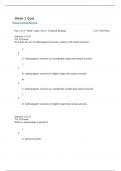
-
ERSC 180 Part 1 of 4 - Week 1 Quiz: Part I - Questions and Answers | Latest 2023/2024 (Graded A+)
- Exam (elaborations) • 23 pages • 2024
-
- $10.49
- + learn more
Week 1 Quiz Return to Assessment List Part 1 of 4 - Week 1 Quiz: Part I - Textbook Reading 72.0/ 72.0 Points Question 1 of 33 3.0/ 3.0 Points How does the size of anthropogenic aerosols compare with natural aerosols? A. Anthropogenic aerosols are considerably larger than natural aerosols. B. Anthropogenic aerosols are slightly larger than natural aerosols. C. Anthropogenic aerosols are considerably smaller than natural aerosols. D. Anthropogenic aerosols are slightly...
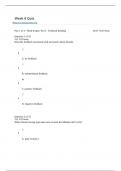
-
ERSC 180 Week 8 Quiz Week 8 Quiz Return to Assessment List Part 1 of 4 - Week 8 Quiz: Part I
- Exam (elaborations) • 23 pages • 2024
-
- $10.49
- + learn more
Question 1 of 33 3.0/ 3.0 Points Describe feedback associated with increased carbon dioxide. A. no feedback B. indeterminant feedback C. positive feedback D. negative feedback Question 2 of 33 3.0/ 3.0 Points What climate forcing type takes into account the Milankovich Cycle? A. plate tectoni
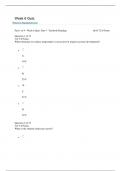
-
ERSC 180 Week 6 Quiz Return to Assessment List Part 1 of 4 - Week 6 Quiz: Part I
- Exam (elaborations) • 19 pages • 2024
-
- $9.49
- + learn more
Week 6 Quiz Return to Assessment List Part 1 of 4 - Week 6 Quiz: Part I - Textbook Reading 66.0/ 72.0 Points Question 1 of 33 3.0/ 3.0 Points What minimum sea surface temperature is necessary for tropical cyclone development? • A. 30oC • B. 25oC • C. 27oC • D. 32oC Question 2 of 33 3.0/ 3.0 Points When is the Atlantic hurricane season? • A. May through September • B. July through October • C. June through November • D. August through December Rational...
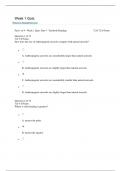
-
ERSC 180 Week 1 Study Week 1 Quiz Return to Assessment List Part 1 of 4 - Week 1 Quiz: Part I
- Exam (elaborations) • 19 pages • 2024
-
- $9.49
- + learn more
Part 1 of 4 - Week 1 Quiz: Part I - Textbook Reading 72.0/ 72.0 Points Question 1 of 33 3.0/ 3.0 Points How does the size of anthropogenic aerosols compare with natural aerosols? • A. Anthropogenic aerosols are considerably larger than natural aerosols. • B. Anthropogenic aerosols are slightly larger than natural aerosols. • C. Anthropogenic aerosols are considerably smaller than natural aerosols. • D. Anthropogenic aerosols are slightly larger than natural aerosols. Question...
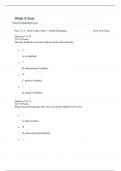
-
ERSC 180 Week 8 Quiz Return to Assessment List Part 1 of 4 - Week 8 Quiz: Part I Questions and Answers | Latest 2023/2024 (Graded A+)
- Exam (elaborations) • 19 pages • 2024
-
- $10.49
- + learn more
Week 8 Quiz Return to Assessment List Part 1 of 4 - Week 8 Quiz: Part I - Textbook Reading 60.0/ 72.0 Points Question 1 of 33 3.0/ 3.0 Points Describe feedback associated with increased carbon dioxide. • A. no feedback • B. indeterminant feedback • C. positive feedback • D. negative feedback Question 2 of 33 3.0/ 3.0 Points What climate forcing type takes into account the Milankovich Cycle? • A. plate tectonics • B. astronomical periodicities • C. solar variab...
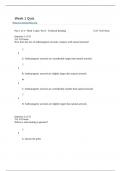
-
ERSC 180 W1 Quiz Week 1 Quiz Return to Assessment List
- Exam (elaborations) • 23 pages • 2024
-
- $9.49
- + learn more
Part 1 of 4 - Week 1 Quiz: Part I - Textbook Reading 72.0/ 72.0 Points Question 1 of 33 3.0/ 3.0 Points How does the size of anthropogenic aerosols compare with natural aerosols? A. Anthropogenic aerosols are considerably larger than natural aerosols. B. Anthropogenic aerosols are slightly larger than natural aerosols. C. Anthropogenic aerosols are considerably smaller than natural aerosols. D. Anthropogenic aerosols are slightly larger than natural aerosols. Question...
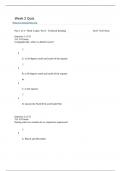
-
ERSC 180 Week 3 Quiz 100%CORRECT AND VERIFIED STUDY QUESTIONS,ANSWERS
- Exam (elaborations) • 24 pages • 2024
- Available in package deal
-
- $9.49
- + learn more
Week 2 Quiz Return to Assessment List Part 1 of 4 - Week 2 Quiz: Part I - Textbook Reading 66.0/ 72.0 Points Question 1 of 33 3.0/ 3.0 Points Geographically, where is albedo lowest? A. at 30 degrees north and south of the equator B. at 60 degrees north and south of the equator C. at the equator D. nearest the North Pole and South Pole Question 2 of 33 3.0/ 3.0 Points During what two months do we experience equinoxes? A. Marc
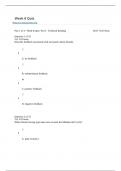
-
ERSC 180 Week 8 Study Questions and Answers | Latest 2023/2024 (Graded A+) .
- Exam (elaborations) • 23 pages • 2024
-
- $8.49
- + learn more
Week 8 Quiz Return to Assessment List Part 1 of 4 - Week 8 Quiz: Part I - Textbook Reading 60.0/ 72.0 Points Question 1 of 33 3.0/ 3.0 Points Describe feedback associated with increased carbon dioxide. A. no feedback B. indeterminant feedback C. positive feedback D. negative feedback Question 2 of 33 3.0/ 3.0 Points What climate forcing type takes into account the Milankovich Cycle? A. plate tectonics
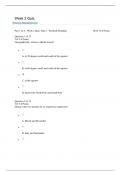
-
ERSC 180 Week 3 Study LATEST TESTBANK LATEST 202,QUESTIONS AND ANSWERS
- Exam (elaborations) • 20 pages • 2024
- Available in package deal
-
- $8.49
- + learn more
Question 1 of 33 3.0/ 3.0 Points Geographically, where is albedo lowest? • A. at 30 degrees north and south of the equator • B. at 60 degrees north and south of the equator • C. at the equator • D. nearest the North Pole and South Pole Question 2 of 33 3.0/ 3.0 Points During what two months do we experience equinoxes? • A. March and December • B. June and
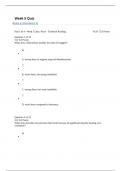
-
ERSC 180 Week 5 Quiz Questions and Answers | Latest 2023/2024 (Graded A+)
- Exam (elaborations) • 23 pages • 2024
-
- $8.49
- + learn more
Week 5 Quiz Return to Assessment List Part 1 of 4 - Week 5 Quiz: Part I - Textbook Reading 45.0/ 72.0 Points Question 1 of 33 3.0/ 3.0 Points What does a Richardson number less than 30 suggest? A. strong shear to support supercell thunderstorms B. weak shear, but strong instability C. strong shear, but weak instability D. weak shear compared to buoyancy Question 2 of 33 3.0/ 3.0 Points What term describes low pressure that forms because of significant daytime heat...

How did he do that? By selling his study resources on Stuvia. Try it yourself! Discover all about earning on Stuvia


